
Luxe, add to cart, buy—Would you spend Rs 1 crore on furniture online?
From a Rs 18 lakh dining table to Rs 1 crore-plus statement piece—uber luxe furniture shopping is going online, and flying off the shelves

Darielle Britto is a Special Correspondent for Forbes India, where she writes about the intriguing luxury lifestyle world and is also part of the web team. She has extensive experience in journalism focusing on long-from written features. Her work has been featured in Daily News Analysis, Hindustan Times and other prominent Indian publications. When not in search of a compelling story, she enjoys being a shutterbug.
- Abhishek Agarwal: Creating wealth by offering health
- Top bridal and fashion jewellery trends dominating this season
- Living that luxe life: Around the world in a private jet
- Trinetra Haldar Gummaraju: Reimagining and recreating, again and again
- The Paris Haute Couture week debut was a moment of great pride for Tanishq: Garima Maheshwari
- No longer a mere possession: Rich millennials are overhauling the luxury yacht industry
- Glamping the great outdoors in uber luxury
- Inside the world of bespoke private jet tours that could rewrite how the rich travel and holiday
- Road less travelled: Why Indians are embracing the allure of luxury road trips
- Living that luxe life: Around the world in a private jet
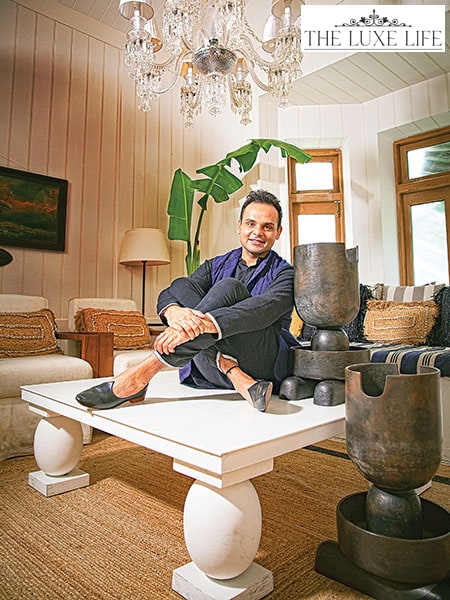 Mumbai-based architect and designer Ashiesh Shah became the first Indian to debut on The Invisible Collection
Image Mexy Xavier
Mumbai-based architect and designer Ashiesh Shah became the first Indian to debut on The Invisible Collection
Image Mexy Xavier
While doing up her London home, Bollywood actor Sonam Kapoor would have gone on little expeditions to Paris and Milan to discover the right items for her sanctuary. But the year was 2020 and a global pandemic put a stop to life as we knew it and made travel almost impossible.
A scenario like this in another lifetime, without digital technology, could have set a project like this way back with little to no access to the missing pieces. Not anymore. Enter the Invisible Collection, an international online marketplace for discovering furniture products from the world’s most renowned talents.
Related stories
Kapoor was introduced to the platform by Mumbai-based architect and designer Rooshad Shroff and stylist Nikhil Mansata, who, at the time, were designing her home and studio, respectively. Luxury furniture ecommerce platforms like the Invisible Collection made the designers more accessible when she had no choice but to buy online.
“Everything’s with a click. You have access to everything online now, which is brilliant,” says Kapoor. “It was easy for me to figure out things online.”
Some of the items sourced from the Invisible Collection are a sofa from French furniture design studio Pierre Augustin Rose (price upon request), Calanque coffee table (£30,505) by French architect and designer Charles Zana, and a Logos sleeper chair and footstool.
Having an understanding of spatial design helped her see the pieces come to life in her home without seeing them in the physical world.
“If someone like Nikhil or Rooshad explains to me or does renders and shows me how a space would look with a certain type of furniture, it’s easy for me to imagine things,” says Kapoor. “I’m used to buying things online, especially when I know it’s coming from a dependable source.”
While the US and the UK remain key markets for the Invisible Collection, they have a vast Indian client base. “Our Indian clients tend to be very knowledgeable about the design market and admire the unique and very French and European approach to decoration,” says Isabelle Dubern-Mallevays, 52, the co-founder of the London/Paris-based platform.
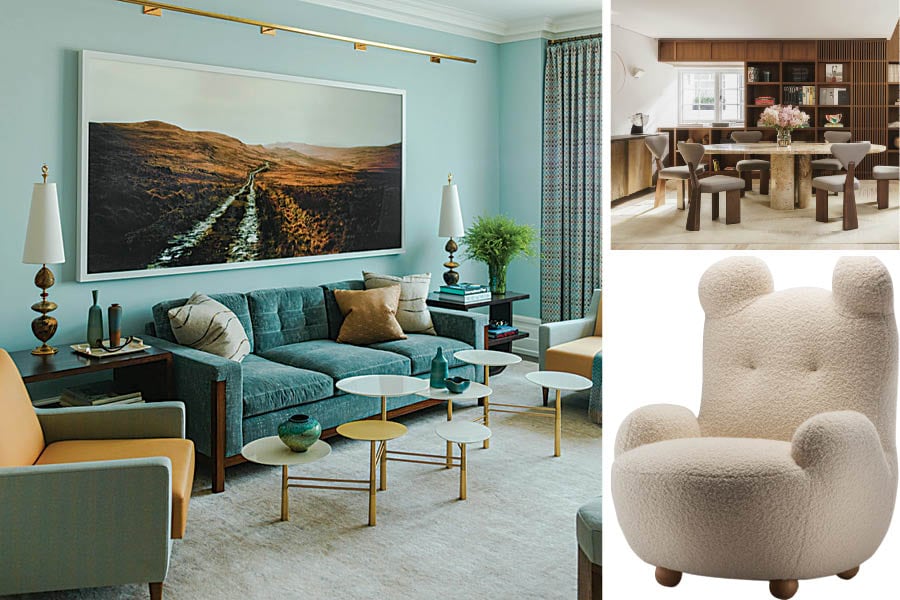 Bespoke funiture items, created by the world’s top designers, which are featured on the Invisible Collection and Papa Bear Armchair by Pierre Yovanovitch
Image: Invisible Collection
Bespoke funiture items, created by the world’s top designers, which are featured on the Invisible Collection and Papa Bear Armchair by Pierre Yovanovitch
Image: Invisible Collection
Gap in the market
The Invisible Collection was born out of a gap in the market as Dubern-Mallevays always wanted to own a Papa Bear Armchair by French interior designer Pierre Yovanovitch, but couldn’t. “Unfortunately, at the time the only way to acquire my dream armchair was to hire Pierre Yovanovitch for a whole interior design project,” she says.
Fortunately, her friend Anna Zaoui, who happened to be working with Yovanovitch on a project in New York, managed to obtain it for her. The two realised that people like Dubern-Mallevays did not have access to a lot of site-specific pieces designed for projects across the world. A concept for the ecommerce platform soon took shape and the pair, along with Lily Froehlicher, launched the Invisible Collection in 2016.
“It seemed strange to us that many fabulous designers did not have a distribution channel,” says Dubern-Mallevays. “We quickly realised our business model was very disruptive although it felt so obvious to us.”
Since the launch, their team has expanded with employees now based across New York, Texas, Los Angeles, Paris and London. Their ever-evolving design roster showcases over 200 designers with worldwide shipping. A rough estimate of the price range of their curated inventory of bespoke furniture is anywhere from £500 to £109,810.
Pieces for the living room by designers such as Charles Zana, Pierre Augustin Rose, Nada Debs, Osanna Visconti are just some of their bestselling items. On average, the platform launches around two new collections per week and ensures the designers they collaborate with are a mix of world-renowned and younger emerging talents.
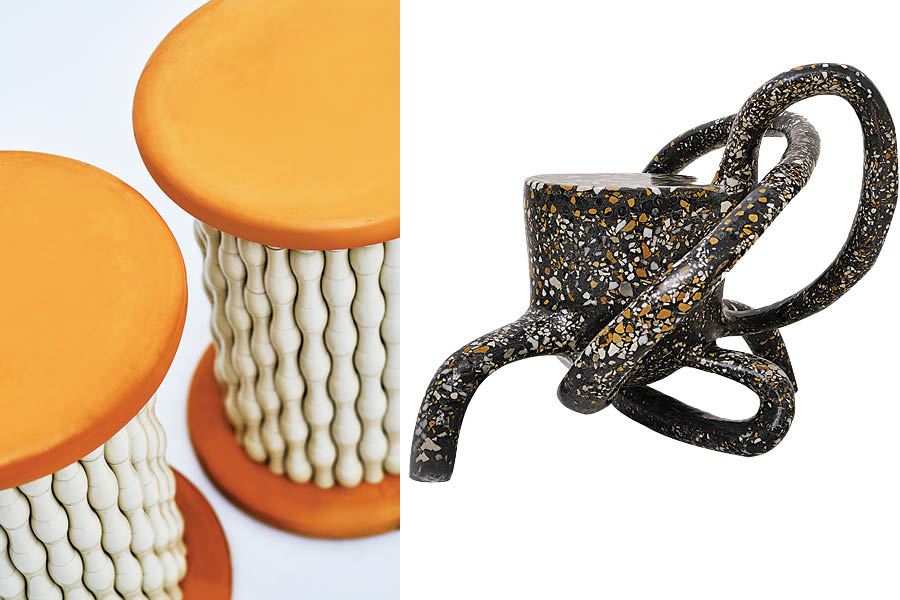 (From left) Channapatna stool, Swayam stool by Ashiesh Shah
(From left) Channapatna stool, Swayam stool by Ashiesh Shah
Giving voice to Indian craft
Earlier this year, Ashiesh Shah became the first Indian designer to debut on the platform. The Mumbai-based architect and designer aims to work with craftsmen from all over the country to create design objects honouring artisanship layered with a contemporary flair.
The design objects, like the Naga Chair (£3,385), Kantilo Console (£12,310) and Channapatna Stools (£2,050) on the platform are designed by Atelier—an extension of Shah’s architectural studio where he creates design objects like furniture—to showcase an array of products ranging from Longpi in Manipur and Kantilo in Odisha to Cast Stone in Gujarat.
“I view this as a platform for the contemporisation of crafts in India while pushing boundaries to ensure that the craft sustains financially,” says Shah.
It is an opportunity to give voice to Indian crafts globally and serve as a medium to change the perception of traditional Indian crafts beyond mere souvenirs. “The platform has helped redefine these objects encouraging craftsmanship and a spirit of artistry by pushing boundaries through scale, form and technique making them relevant to a global audience,” says Shah.
In 2013, Astha Khetan was on a similar mission to shed light on designers and craftsmen from all over the world when she founded Udaipur-based company The House Of Things—an ecommerce platform offering high-end furniture, accessories, lighting, and art sourced from over 200 brands.
“Our model initially was to source unique pieces from brands and to ship across India, which soon turned to servicing 150 other countries over the span of three exciting years,” says Khetan.
Sourcing unique, classic and avant-garde pieces from talents like Nikhil Paul, Mousarris, Duffy London, Scarlet Splendour is the company’s USP. The price range varies from a coffee mug priced at ₹600 to a high-end statement table priced at ₹1,04,46,000. “One of the recent sales would have to be The Up Balloon Dining Table by Duffy London, priced at ₹18,15,284,” says Khetan.
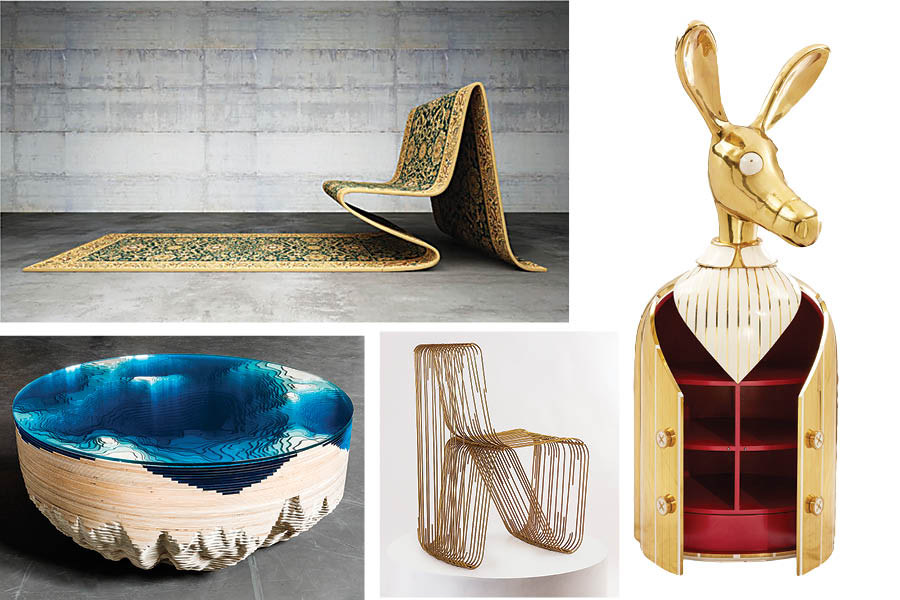 (Clockwise from above left) The Carpet Sofa by Mussaris; the Donkey Bar Cabinet by Scarlet Splendour, at The House of Things; Glitch by Nama Home; Abyss Horizon by Duffy London
(Clockwise from above left) The Carpet Sofa by Mussaris; the Donkey Bar Cabinet by Scarlet Splendour, at The House of Things; Glitch by Nama Home; Abyss Horizon by Duffy London
Going north
The global luxury furniture industry reached a value of $22 billion in 2021. Consultancy firm IMARC Group expects the market to reach $29.6 billion by 2027, growing at a CAGR of 4.97 percent during 2022-2027. Mordor Intelligence predicts the Indian luxury furniture market to exhibit moderate growth at a CAGR of more than 4 percent during the forecast period 2021-2026.
Platforms like the Invisible Collection and The House of Things can contribute to that growth even though it is still early in the game and more time is needed to understand the market better.
Abhay Gupta, 65, CEO of Luxury Connect, a Gurugram-based advisory firm to luxury brands, believes growth is going to go north as an increasing number of international banks are encouraging big-ticket purchases and taking care of the logistics involved in shipping it across the globe. “People, irrespective of whether they are HNIs, have moved towards the digital medium,” says Gupta.
Shah’s clientele has seen a 30 percent growth since launching on the Invisible Collection. “We are probably pioneers in the segment and I’m certain our experiences will pave the way for future generations of designers,” says Shah.
In the last three years, The House of Things has seen phenomenal growth. Being homebound during the pandemic has made people want to turn their homes into personal sanctuaries, spend more on furniture and home décor items, and opt for timeless and versatile pieces, says Khetan. “On the website, every day there are usually 2,000 users, both Indian and international, from countries like the USA, the UK, the UAE, and Australia.”
Also read: India is one of our biggest growth markets: IKEA India CEO
Getting comfortable with digitalisation
Millennials and Gen Z will account for nearly half of the total luxury goods sales by 2025, making the global luxury industry worth €290 billion, predicts consultants Bain & Company. An Insider Intelligence report reveals there will be 312.7 million digital buyers in India, up 47 million from 2020. The country is expected to add close to 65 million more digital buyers between 2022 and 2025.
New generations of consumers is changing the luxury industry in India and globally, making digital channels more important sources of inspiration and sales.
Consumers are using the internet to discover, research, and compare products before purchasing them online or in a physical store. “With their desire for mobile-first shopping experiences, consumers today are changing the rules for marketers and online platforms by favouring seamless retail experiences whenever and wherever they want,” says Khetan. “Personalisation, innovation, and exclusive experiences have replaced qualities like brand heritage, personal service, and exclusivity.”
Gaining experience and confidence in purchasing items online is key to driving demand in the future. A customer satisfied with the quality, as well as the pre-and post-sale service, Gupta says, will slowly get comfortable venturing into making purchases for bigger ticket items, like high-end furniture.
Covid has also altered consumer behaviour, whereby many prefer socialising at home. “Today, homes have become a very big category, driving demand for home interiors,” says Gupta.
The industry is responding to this as acceptance of technology to create different mediums of transactions is becoming increasingly normal. “So many options have come up because of Covid. They are driving growth for these categories, for which online purchases were a taboo earlier,” says Gupta.
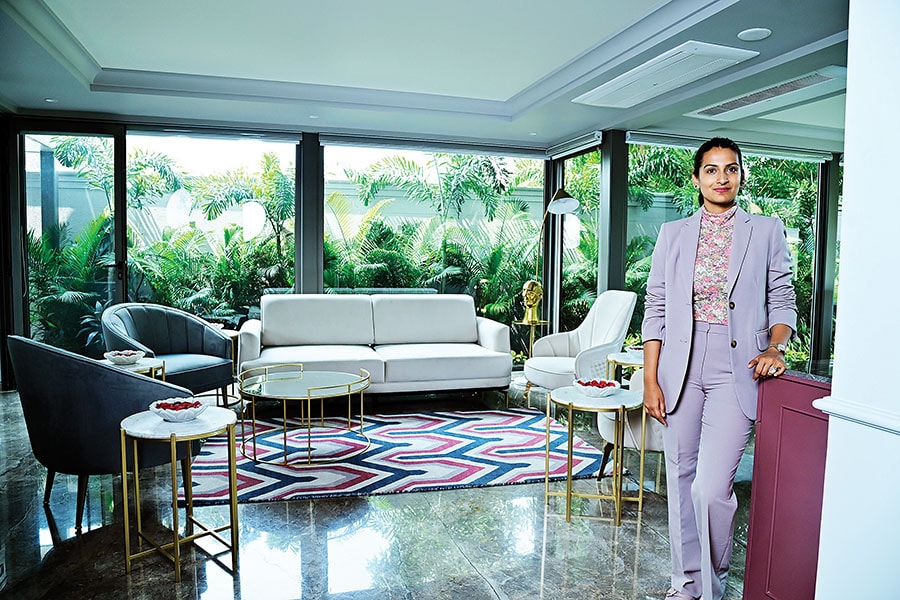 Sajni Vora visited the Udaipur store of House of Things before finalising her purchase Image: Mayur D Bhatt for Forbes India
Sajni Vora visited the Udaipur store of House of Things before finalising her purchase Image: Mayur D Bhatt for Forbes India
Gamechanger for customers and designers
Creating sensory experiences at furniture stores helps potential buyers connect with the offerings. Selling high-end furniture pieces without this experience can be even tougher. While some customers, like Kapoor, are more comfortable with purchasing expensive furniture items online, Ahmedabad-based fashion designer Sajni Vora, 29, needed a little more convincing.
Vora randomly came across The House of Things on the web when she was looking for stylish, luxurious, and comfortable furniture pieces to add to a new space, which is an extension of her home. She was impressed by the site and a few things caught her eye, like a sofa-cum-bed, long bar chairs and a small traditional table. It also gave Vora access to a wider range of designers that she otherwise may not have come across if it wasn’t housed in one place.
But, before placing the order, Vora had the opportunity to visit the company’s Udaipur store where she got to see and try out the pieces. She was even able to have them customised to fit the colour scheme she wanted in that space.
That experience has helped her gain more trust in the digital process, but, like many others, she will not be fast to embrace it fully. “Now if we have to reorder from The House of Things, I don’t have to go and visit because I already know the quality,” says Vora. “But if it’s some other brand and it’s expensive, I would want to see that product first.”
It may be a tough market to crack, but for Shah, platforms like these are a step in the right direction. “By building trust through our work, we are trying to change that trend,” he says.
The exposure on the Invisible Collection has opened Shah up to an international market with several new clients from Mexico, Singapore, the Middle East, Canada and the UK, to name a few. It has also paved the way for interesting interactions with other creators on the platform. “We are looking at collaborations and interesting dialogues with artists and fellow designers in the near future,” he says.
Also read: How third-time entrepreneur Srikanth Iyer got it right
Managing consumer expectations
Simply purchasing an object online is not enough to make an indulgent purchase special for luxury consumers of today. It’s all about the browsing and learning experience. Ecommerce platforms in this space are re-establishing the authentic concept of luxury based on provenance, craftsmanship and quality.
“We aim to communicate the story of our makers through interviews, videos and social media interactions; bringing great design to a world-wide audience,” says Dubern-Mallevays. “Interior styling services, digital ad spends, curated looks, etc are all helping designers and consumers shop online more confidently.”
Khetan is on a mission to change the way people perceive, browse and own luxury interiors in several ways. “Matching the standards of services with a brick-and-mortar store, which an affluent consumer has come to expect, are some of the challenges being faced,” she says. “A well-informed concierge, white-glove delivery/logistics, and exceptional service really help address the challenges.”
Also read: Milan designers visualise the post-pandemic home
Future is Phygital
Furniture, like other product categories—cars, jewellery, real estate—is going to move online, but Gupta predicts the future of shopping is going to be phygital, where the physical and digital worlds will be linked. “The physical store will remain,” says Gupta. “It’s not going to die away, but they’ll probably get converted into experience centres.”
“More and more products will be available online, but when you want to experience something, the touch and feel for that part, you will go to the offline store,” he adds.
The Invisible Collection has expanded its digital presence with showrooms in London, Paris and recently New York. “Ultimately, we want to be the first brand of a ‘new luxury’ in decoration,” says Dubern-Mallevays.
Some of the works thoughtfully created from Shah’s studio are making its way across the globe to be showcased at the Invisible Collections galleries and the Gallery Volt in Dubai. “The Atelier has paved the way for several Indian and international designers foraying into the luxury design space,” he says.
(This story appears in the 30 November, -0001 issue of Forbes India. To visit our Archives, click here.)







